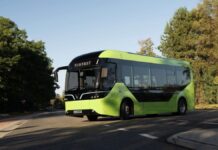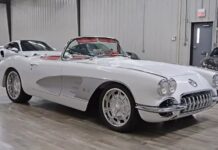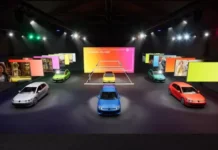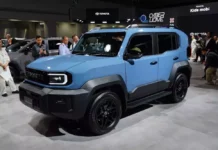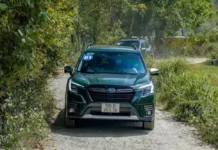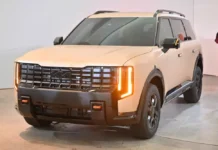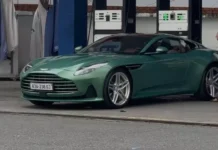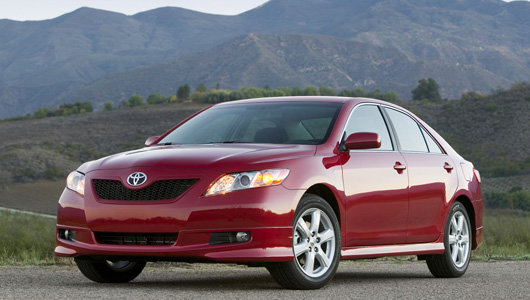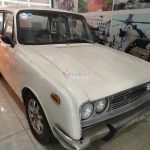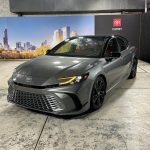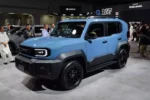The all-new generation Camry model has just been officially released by Toyota in the Vietnam market, let’s take a look back at the development history of the previous 6 generations of Camry.
>> Camry 2012 – “King” of the mid-size sedan debuted in Vietnam
>> Toyota Camry 2012 – Worthy of the throne
Part 2: Camry Generations
1st Generation (1982-1986)
In 1982, Camry became a separate model and was sold as a mid-size 4-door and 5-door sedan. The export volume was very small, mostly for right-hand drive markets. At that time, Camry was positioned above two other mid-size models of Toyota, Carina and Corona. A twin sibling was also introduced: Toyota Vista.
Camry only had a 2.0L inline 4-cylinder engine, 92 horsepower, but had 2 gearbox options: 5-speed manual and 4-speed automatic. In contrast to the rear-wheel drive Celica Camry, Toyota Camry was front-wheel drive.
The design of the first generation Camry was in line with the boxy trend of the early 1980s. The size and equipment of the car were the characteristics of Japanese cars at that time, affordable and compact yet sturdy and directly competitive with the large American rivals.
2nd Generation (1986-1991)
The second generation was introduced in 1986, adding a wagon model and discontinuing the hatchback model. It was still considered a mid-size car at that time. In 1988, the AWD (4-wheel drive) version was first introduced with a 2.5L V6 engine, 160 horsepower. This V6 engine had a DOHC (double overhead camshaft) configuration, similar to the 4-cylinder 115 horsepower engine.
The factory in Kentucky started producing Camry in 1988, with three models of the 2nd generation: standard Camry, Camry DX, and Camry LE. The 2.5L engine and chassis of the Camry were also used for the upscale Lexus ES250. The ES250 was a distinctive model for the Camry hardtop version (a hardtop type without a middle pillar between the 2 windows) in the Japanese market.
In 1991, the Anti-lock Braking System (ABS) was equipped on V6, LE, and wagon models.
3rd Generation (1991-1996)
The 3rd generation Camry was sold in Japan in 1990 and introduced in the US as the 1992 model. It was considered the first Toyota model to enter the large sedan segment, which Toyota called “world-sized”. This marked a transition for Camry from an affordable 4-door car to a larger and more advanced sedan.
However, the 1992 Camry in Japan was different. The doors and front and rear bumpers were the same as the export models, but the width was limited to 1,700mm to comply with domestic tax regulations. The wider export model in Japan was called the Toyota Specter.
In the US, the automatic transmission became the only option for all models, but the sporty 5-speed manual version of the previous generation Camry was still available. Both the 4-cylinder and 6-cylinder engines were upgraded in displacement and horsepower: 2.2L 4-cylinder with 130 horsepower, and 3.0L V6 with 185 horsepower. In addition to the DX (also called Delux) and LE models, the 1992 model also added the high-end XLE and sporty SE models, which were aimed to compete with the Nissan Maxima SE.
In 1994, a 2-door Camry model with a similar appearance to the 4-door variant was introduced. This model was discontinued in the next generation, but was later replaced by the Camry Solara.
At the same time, in the domestic market of Japan, there were two new models (1,700mm wide) of Camry and Vista, with the same chassis but different body types.
The 3rd generation Camry was listed in Car and Driver’s “10 Best Cars” in 1992 and 1993.
4th Generation (1996-2001)
The 4th generation Camry was introduced in Japan in December 1996. There were still sedan and wagon models (called Camry Gracia in Japan), while in the US, only the sedan variant was available from the 1998 model year. The 2000 model had minor enhancements at the front and rear, but overall did not differ much from the 1999 model. The Specter model was phased out in Japan as the Camry’s width was increased to 1,795mm.
The Lexus ES300 once again shared its platform with the Camry. In 1999, the Camry Solara 2-door model was introduced with convertible and coupe variants. Unlike the 2-door Camry of the 2nd generation, this Camry Solara started as a 4-door model.
In 1988, in the US market, the old SE sporty line was discontinued, and the standard line was renamed as Camry CE. Both the LE and XLE lines were continued. The Solara model had two variants, SE and SLE, corresponding to the LE and XLE of the sedan line. The XLE had both a 4-cylinder engine and a V6 engine, while the Solara SLE only had a V6 engine.
The horsepower was slightly increased, with a 2.2L 4-cylinder engine producing 133 horsepower, and a V6 engine producing 194 horsepower. The manual transmission was only available for the CE model and Solara models.
The first Camry was sold under the name of Daihatsu. It was the Daihatsu Altis, also considered an exported Camry model. The Camry V6 was listed in Car and Driver’s “10 Best Cars” in 1997.
5th Generation (2001-2006)
In September 2001, the last Camry model was introduced as a larger sedan (with an attractive design inspired by the Vitz, Corolla, and Solara Coupe), but there was no station wagon version like the first time (a similar wagon model was sold in the Japanese domestic market under the name Toyota Mark II Blit). In some other places, the Camry station wagon was replaced by the Highlander crossover SUV.
The 5th generation was somewhat similar to the 4th generation in terms of their gentle curves. However, the front end of the car was shorter, but the passenger cabin was longer, a technology inherited from compact car models.
In 2002, in the US market, the CE model was cut down, but the sporty SE model was introduced. Both the LE and SE models were equipped with manual transmissions and a 4-cylinder 3.0L engine with 255 horsepower. Some models could be equipped with a V6 engine or an automatic transmission, but the V6 models were not available with a manual transmission. Also in this year, the Camry Solara model remained based on the 4th generation chassis, but the Solara received an upgraded 2.4L engine similar to the one used in the Camry.
In 2004-2005, the Camry introduced a new model with chrome-plated grille (the SE model had a sporty grille), a new design, and new wheels, but at a lower price than the Camry LE.
The 2nd generation Camry Solara was introduced in August 2004, again having a completely different style from the previous Camry, with an elegant design inspired by the Lexus SC 430. It still had a 2.4L engine, but there was an option for a 3.3L V6 and a 5-speed automatic transmission.
6th Generation (2007-2011)
The 6th generation Camry was a perfect design, it was assembled at Toyota’s factory in Georgetown, Kentucky, and Subaru’s factory in India. The 2007 model was first introduced at the North American International Auto Show, accompanied by a similar version, the Camry Hybrid (Camry HV).
The new Camry had a 2.4L I4 engine with 158 horsepower, with 4 compact versions: CE, LE, SE, and XLE. The car also had other options such as a 3.5L engine with 268 horsepower, available for the LE, SE, and XLE versions.
Thu Ha (TTTÐ/General)

